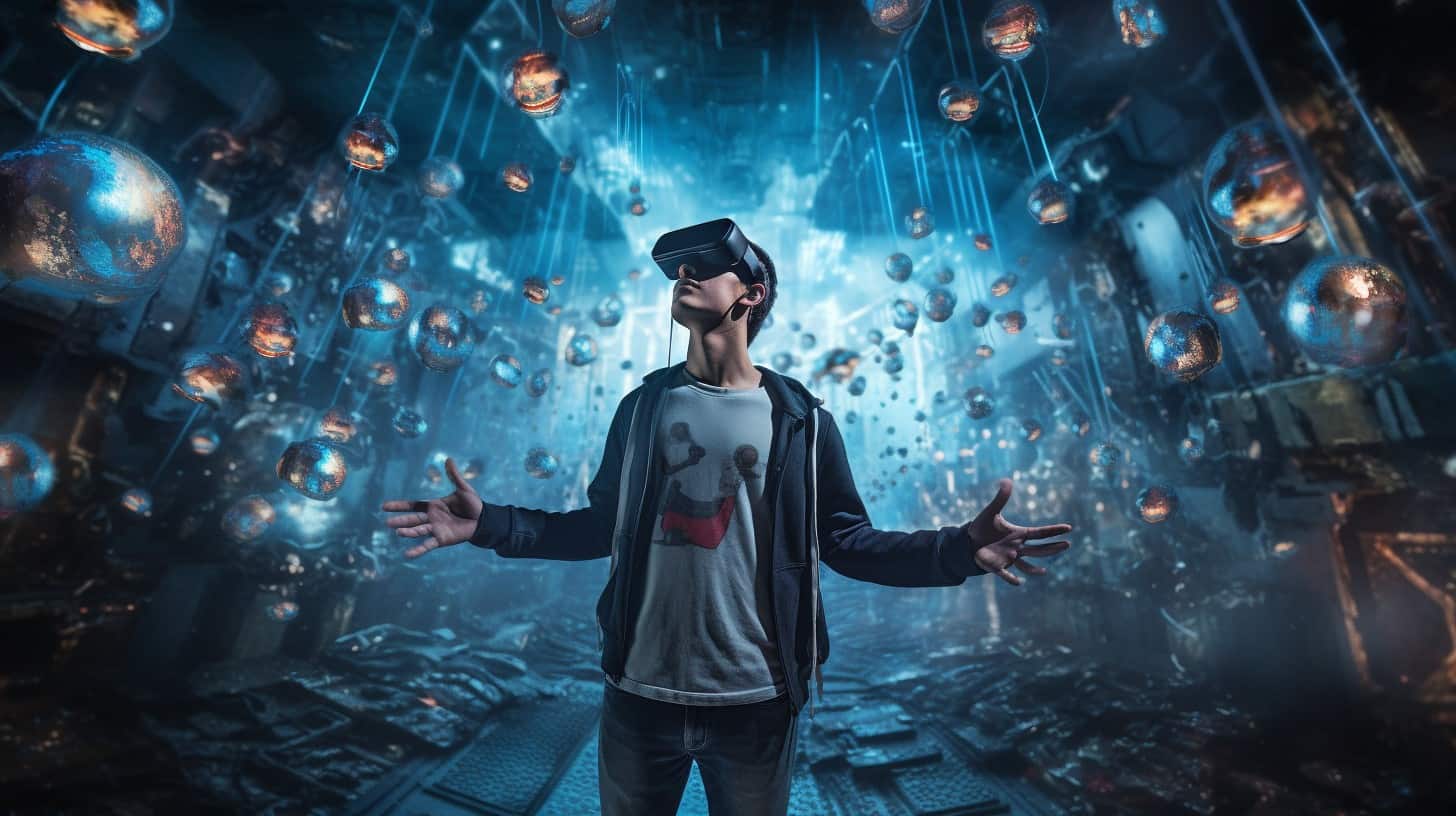Are you feeling like your gaming routine has become a little too predictable, like there’s nothing new on the horizon? Trust me, I know that feeling all too well. But don’t worry – after embarking on an epic journey through the sprawling universe of VR, I’m here to spill the beans on some unique experiences waiting for you.
This guide is your secret map to hidden gems in virtual reality that goes far beyond traditional games. Get ready to be wowed by immersive films and personal growth opportunities like conquering fears.
Prepare for a leap into the uncharted territories of VR – we’re about to set sail!
Key Takeaways
VR isn’t just for games; it lets you watch movies with friends, face your fears like the fear of heights, and find peace through meditation.
You can make new friends, work out in fun ways, and get creative by painting or designing in 3D spaces—all in virtual reality.
Travel to different places around the world without leaving home and shop in virtual stores that feel like real-life malls.
Table of Contents
Immersive Movie Watching Experience in VR
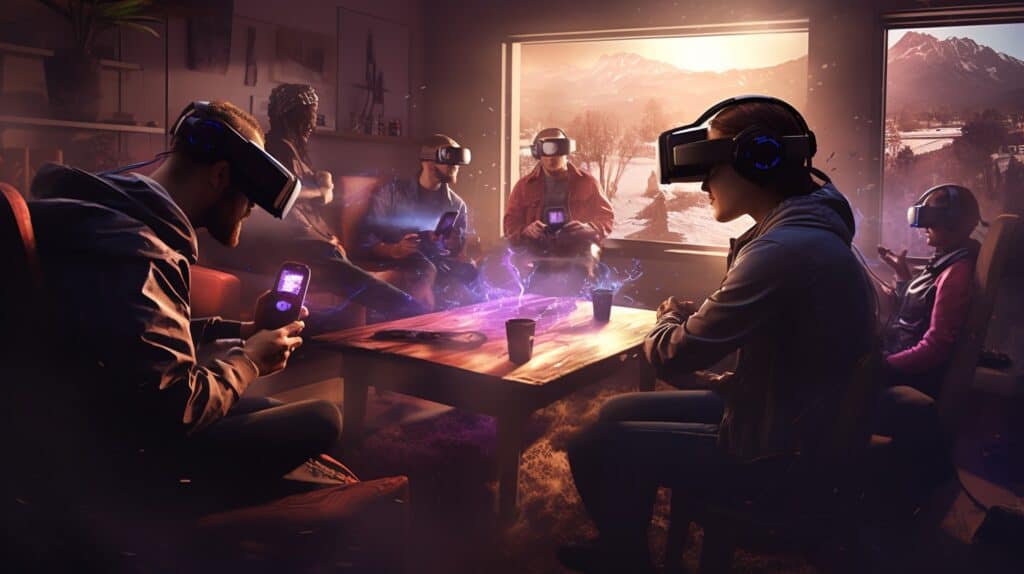
Dive into a cinematic universe like never before; VR transforms your movie-watching into a full-sensory adventure that transcends the traditional couch and popcorn setup. Picture yourself in the heart of the action, engaging with every scene as if you were part of the narrative itself.
Watching Movies & TV Shows with Friends in VR
I love movies, and watching them in VR is like being in my own private theater. I can even invite friends to join me, no matter where they are!
- Put on your VR headset and pick a movie or show. There are apps just for this.
- Choose a virtual room to watch in. It can look like a cinema or something cool like space!
- Invite your friends to watch with you. They put on their headsets and join the same room.
- You all see the same screen, so it feels like you’re together.
- Chat with your pals while watching, just like at the movies.
- Share snacks virtually! You can’t really eat them, but it’s fun to pretend.
- React to the movie together. Laugh, jump, or shout at the same parts.
- Use avatars to represent yourself. Pick how you want to look in VR!
- Pause the movie anytime if someone needs a break.
Overcoming Fears with VR
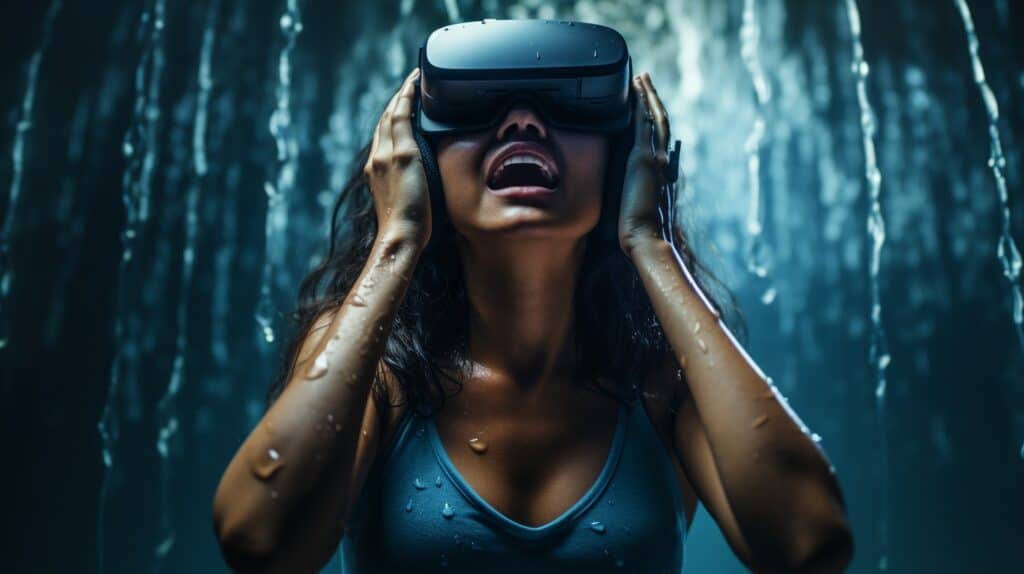
Imagine standing atop a skyscraper without the risk, as virtual reality can be your safe haven to conquer phobias—keep reading to uncover how VR empowers you to face and overcome your deepest fears head-on.
Overcome Your Fear Of Heights with VR
I used to be scared of heights, but not anymore. Virtual reality gave me a new way to tackle my fear without stepping outside.
- Get VR gear like Oculus Rift or HTC Vive.
- Try “Richie’s Plank Experience.”
- Start slow.
- Use it often.
- Make it fun.
- Track progress.
I know firsthand that facing my fear of heights with virtual reality works! It can help you too.
Mindfulness and Relaxation in Virtual Reality

Dive into a serene oasis with VR; it’s not just for adrenaline junkies. Embrace virtual reality to find your Zen, transforming mindfulness and relaxation into an immersive journey that clears the mind and soothes the soul.
Immersive Mindfulness Meditation in VR
I need to clear my mind sometimes, and virtual reality meditation is amazing for that. It feels like I step into a peaceful world where stress doesn’t exist.
- Put on your VR headset and find a quiet place to sit or lie down.
- Start up apps like Guided Meditation VR or theBlu to escape into tranquil environments designed for relaxation.
- Choose your favorite setting; maybe it’s a beach, forest, or even outer space.
- Listen to the calming voice guiding your breathing and helping you focus.
- Notice the details around you in the virtual world—the sounds of waves, birds, or gentle music.
- Feel how your real-world worries fade away as you breathe deeply and let go of tension.
- Use this time to focus on positive thoughts and feelings, creating a sense of inner peace.
- Enjoy these moments without interruptions from outside noise or distractions.
- Make this a habit to help manage stress and improve your mental health regularly.
Adult Entertainment in Virtual Reality

Dive into the provocative world of Virtual Reality, where adult entertainment takes on a heightened level of intimacy and immersion—just one more surprising avenue that VR unlocks for discerning adults seeking novelty beyond the mundane.
Experiencing Adult Content in a New Way: The Immersion of VR
Virtual reality brings a whole new level to watching adult movies. With an 8k VR Porn experience, everything feels super real and close. It’s like being in the same room where the action is happening.
You can look around and see everything from different angles, which makes it very different from just watching on a screen.
This kind of VR isn’t for everyone, but if you’re curious, it offers a deep sense of being there that no other tech can match right now. It’s more intense and personal. Just remember to stay safe online and make sure any virtual space you enter respects your privacy and rules.
Musical Entertainment and Learning in VR
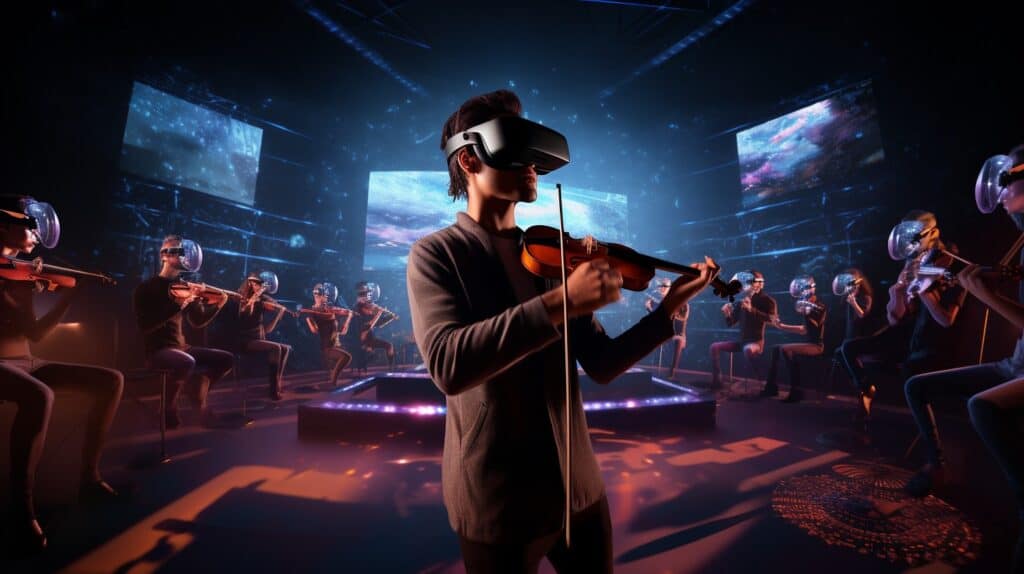
Dive into a symphony of virtual experiences where music isn’t just heard but felt and interacted with; VR brings the power to play, compose, and learn instruments like never before.
It’s not merely about listening anymore—immerse yourself in learning music theory or strumming a guitar alongside an AI instructor, transforming how we engage with melodies.
Play or Learn an Instrument with VR
I just found out about something cool for us guys to try. Virtual reality isn’t just for games; you can actually learn to play instruments in VR.
- Strap on a VR headset and step into a virtual music studio. You’ll find apps like Paradiddle that let you bang on the drums as if they’re right in front of you.
- Pick up piano skills without needing a real piano. With apps like VRTuos, you can practice on virtual keys anytime, no matter how small your space is.
- Make noise without worrying about complaints from neighbors or roommates. Your VR headset transports you to a place where you can play loud and not disturb anyone.
- Save money because you don’t have to buy expensive instruments. VR gives you access to many different types of instruments without the cost.
- Practice at any hour, whether it’s late at night or early in the morning. Since it’s all virtual, you won’t be keeping anyone awake with your learning sessions.
- Improve faster thanks to interactive lessons and tutorials available in VR. These guides help keep your learning fun and engaging.
- Share your music with friends online. Some VR platforms let other people hear what you’re playing, turning it into a social experience.
Socializing in the Virtual Sphere
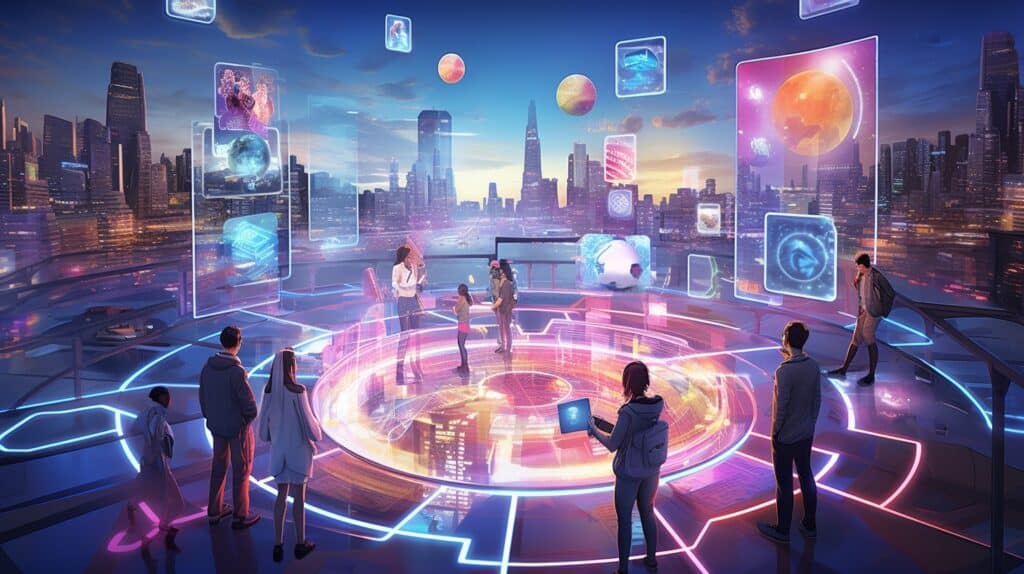
Dive into the virtual sphere, where you can forge genuine connections and friendships spanning across continents; keep reading to discover how VR transforms the art of socializing.
Meet New People And Make New Friends With VR
I love using VR to meet new folks and make friends. It’s like stepping into a world where everyone wants to chat and hang out.
- Slide on your virtual reality headset and jump into places like VRChat or Rec Room. You’ll find people from all over who are there to have fun and socialize.
- Create an avatar that shows off your style. Pick your clothes, hair, and even superpowers! This is how others see you in the VR space.
- Join group activities or games. Whether it’s a quiz game or a virtual escape room, doing things together can start great friendships.
- Visit virtual hubs based on hobbies for men in their 20s or find groups for older men with similar interests. There are spots for music lovers, fitness buffs, car fans, and more.
- Chat about health tips for men or share workout routines during a VR workout session; conversations can be about anything!
- Host a get-together in your own private virtual room. Invite people you’ve met or make it open for newcomers looking to socialize.
- Share your favorite music or watch videos together with apps that let you stream inside the virtual world. It’s like hanging out in real life!
- Support each other when trying new things in VR, whether that’s climbing a mountain or creating art with Tilt Brush.
- Exchange usernames and keep in touch outside of VR too. Many people build lasting friendships this way.
Fitness and Wellness in Virtual Reality
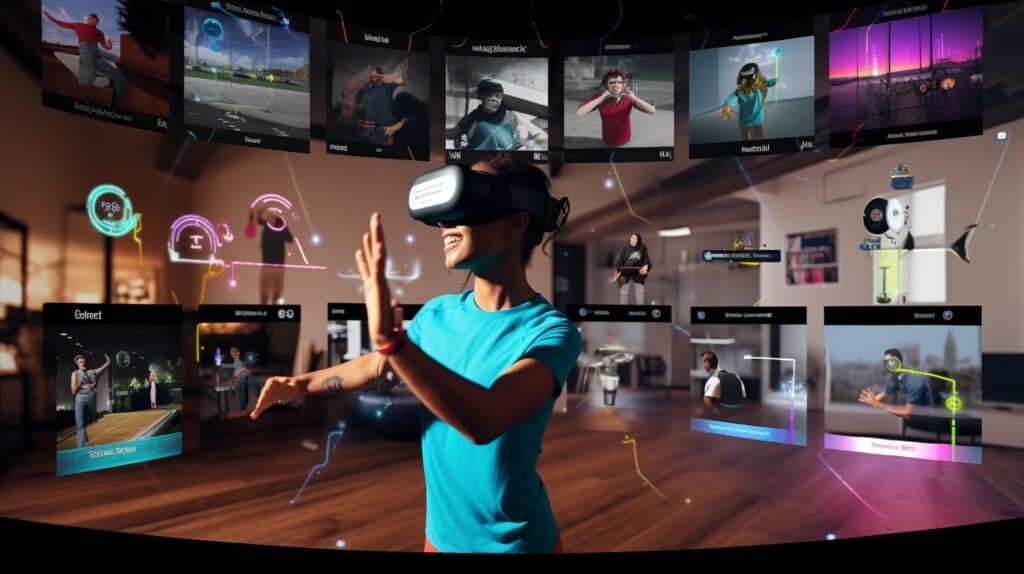
Ditch the mundane treadmill routine and embrace a revitalized approach to well-being with fitness in virtual reality. Embody your healthiest self; engage in immersive workouts that challenge body and mind, all within the comfort of your personal space.
Use VR to Work Out
I love working out but sometimes get bored with the same old routine. Virtual reality has changed the game, making fitness fun and exciting.
- Slip on a VR headset and jump into a new world where exercise meets adventure.
- Grab VZFit or Holofit subscriptions to pedal through scenic landscapes all from your bike at home.
- Dance off calories without feeling like you’re working out with apps like Supernatural VR for Oculus Quest.
- Feel the burn with VRWorkout; no equipment needed, just your body moving in sync with the game.
- Punch, block, and weave using boxing games in VR that get your heart pumping.
- Join online classes and compete with friends or strangers to push each other’s limits.
- Track your progress within these apps and set new fitness goals to keep improving.
- Enjoy full-body workouts that make you forget you’re exercising because it feels more like playing a fun game.
Creativity and Design in VR
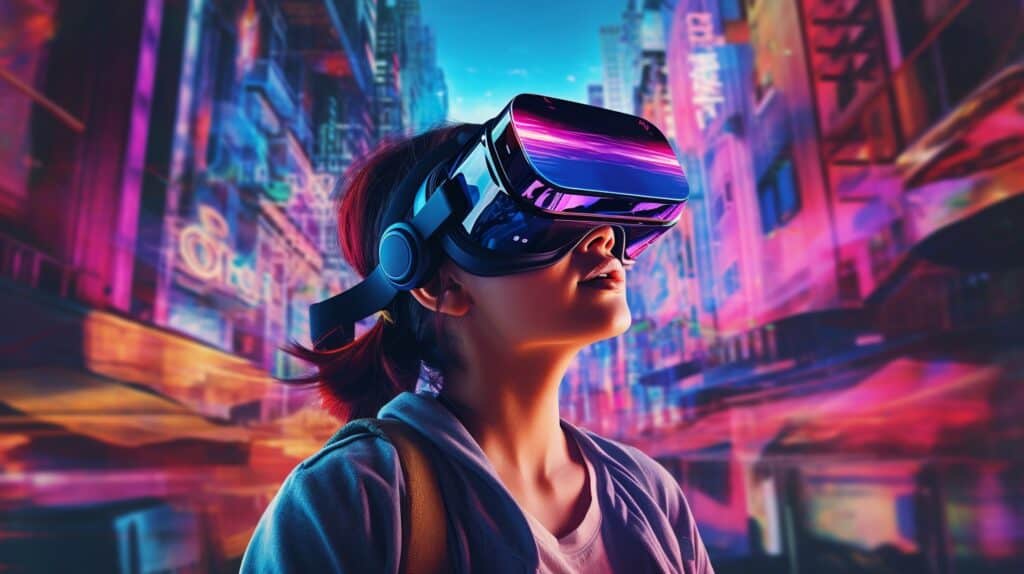
Unleash your inner artist with virtual reality, where the boundaries of creativity are redefined. From sculpting digital masterpieces to designing your dream home, VR transforms how we create and innovate, offering tools that push the limits of imagination.
Use a VR Headset to Get Creative
I love finding new hobbies, and virtual reality (VR) is not just for gaming. It lets me get super creative in ways I never imagined before. Here’s what you can do with a VR headset to unleash your creativity:
- Paint like a pro, even if you’re not one. Imagine splashing colors on a huge 3D canvas floating in front of you. With apps designed for painting in VR, you can create masterpieces that move and change. It feels like magic when your art comes to life around you.
- Design stuff without needing a whole workshop. You can build anything from furniture to spaceships in a VR environment. Use design applications that make it easy for anyone to shape their ideas into real-looking models.
- Make your own worlds to explore. Fancy walking through a city of your own making? Some VR apps let you craft landscapes and buildings. Then, you can visit them as if they were real places.
- Try ceramics without the mess. Ever thought about shaping pottery but didn’t want the hassle of clay everywhere? In VR, there’s no need to clean up! You can experience the joy of ceramics-making virtually, molding and adjusting as much as you want.
- Dive into an immersive meditation space. VR also provides peaceful environments for mindfulness practices. If my mind is racing, I put on my headset and find myself in tranquil scenes that help me chill out.
Virtual Travel and Exploration

Exploring new destinations from the comfort of your own home has never been more captivating than with virtual reality; get ready to traverse exotic locales and historic landmarks without packing a suitcase.
Explore The World in Virtual Reality World
I can travel the world without leaving my hotel room. Putting on a VR headset takes me to places far and wide.
- Pick any destination: I choose where to go. From the pyramids of Egypt to the streets of Tokyo, it’s all there in a virtual environment.
- Real-world sights: The images are so clear, it feels like I’m really there. Famous landmarks come to life in my living room.
- Interactive experiences: I don’t just look around; I get to do things. Maybe I’ll ride a gondola in Venice or climb a mountain in the Himalayas.
- Virtual tours with guides: Sometimes, real tour guides lead the way. They tell me interesting facts about what I’m seeing, just like on a real trip.
- Meet locals and travelers: In some virtual worlds, other people are exploring too. We can chat and share our experiences as if we were there together.
- Cultural events and festivals: VR can take me to Mardi Gras or the Running of the Bulls. I witness these events up close without any crowds or risk.
- No lines or tickets: One huge plus is skipping lines and ticket costs. In VR, every place is open and free anytime I want to visit.
- Safe travels always: There’s no worry about lost luggage or flight delays here. And if something scares me, like heights, I just take off the headset.
- Virtual souvenirs: Yes, even shopping is possible! Some apps let me buy virtual goods from different countries as souvenirs.
Virtual Shopping Experiences
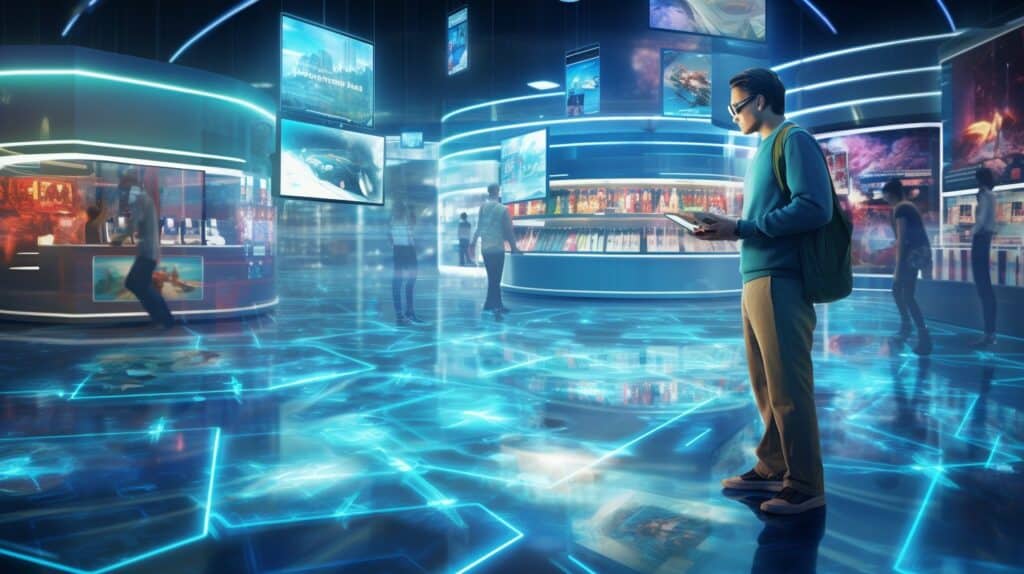
Imagine the convenience of browsing through aisles of products from the comfort of your own space; virtual shopping experiences in VR are revolutionizing how we buy. With a headset, you can visit dynamic 3D stores, inspect items in detail, and enjoy enhanced retail therapy without stepping out the door.
Shopping with VR Headset
I just found out that I can shop with my VR headset, and it’s a game-changer. It’s like bringing the whole mall into my living room without stepping outside.
- Slip on your VR headset to start your shopping trip from home.
- Enter virtual stores designed to look like real shops, full of items you can check out.
- Look at clothes, electronics, or anything else just by gazing or pointing.
- Try on outfits in a digital dressing room where you see them on your avatar.
- Check out sizes and colors by simply clicking or tapping options in VR.
- Get a 360-degree view of products to inspect them from all angles.
- Add items to your virtual cart without carrying a basket or pushing a cart.
- Pay with secure methods – it’s shop till you drop, minus the heavy bags.
Thrill-seeking in Virtual Reality
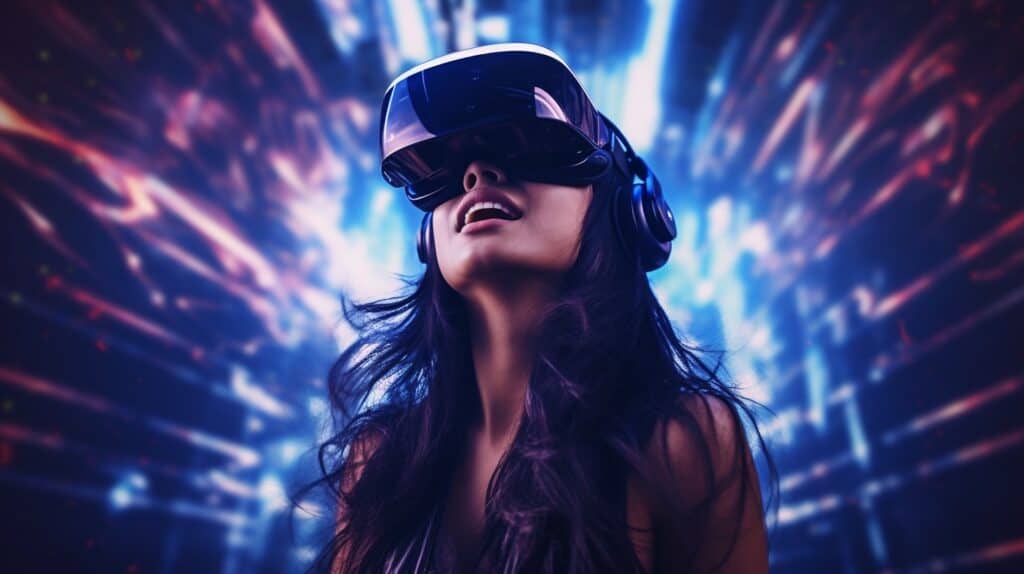
Dive into the adrenaline-fueled world of virtual reality, where thrill-seekers can leap from dizzying heights and race at breakneck speeds, all from the safety of their living room.
Virtual reality offers a gateway to extreme experiences that challenge your nerves without stepping foot outside, perfect for those seeking excitement without real-world risks.
Skydiving in a Virtual World
I love feeling the rush of jumping out of a plane, but I’m not always up for the real deal. VR skydiving gives me that thrill without any risk.
- Strap on your VR headset and prepare to fly. You’ll feel like you’re truly leaping from thousands of feet up.
- Choose your skydiving location in the virtual world. You could jump over mountains, cities, or even fantasy landscapes.
- Feel safe knowing it’s just a simulation. There’s no need to worry about weather, equipment failures, or fear of actual heights.
- Experience sky-diving solo or with friends. Yes, you can join others in VR and share the rush together!
- No special training needed in VR. Unlike real skydiving, there are no classes or prior jumps required.
- Adjust your experience level. Beginners can enjoy an easy float down, while pros can go for trickier dives.
- Save money on this hobby. Real skydiving can cost a lot per jump, but with VR, it’s way cheaper.
Final Thoughts on Expanding Your Virtual Horizons
Look at all these cool ways to use VR! You can watch movies with pals, face your fears, or chill out with some meditation. Meet new folks, get fit, or even learn an instrument. And hey, you can travel the world without leaving your couch! Isn’t it amazing what we can do now beyond just playing games?
FAQs About Things To Do In VR Beyond Gaming
What can I do with VR besides gaming?
You can try many cool things in VR, like exploring new places, learning in virtual classrooms, watching plays in immersive theater, and even trying virtual racing for some fun.
Can I use VR to learn new hobbies if I’m an older man?
Yes! Older men can enjoy hobbies in VR, like virtual flying with a flight stick or driving fast cars in games like Assetto Corsa, all from the comfort of their homes.
Is it possible to shop using VR?
Sure is! Stores are starting to use VR so you can check out goods as if you were there. You could look at clothes, furniture, or even more without going to real stores.
How are businesses using VR other than for fun stuff?
Businesses use it for showing off products with high-resolution images and videos or creating ads that feel real! They’re also training people by simulating tough jobs like surgery.
Can I experience Mixed Reality at home with my own device?
Definitely! Devices like HoloLens mix the real world with computer stuff right before your eyes — magic!
Are there ways VR helps doctors and medical students?
Yes indeed! Medical folks use it to practice heart surgeries and study the body closely without having a real person on the table—it’s super helpful for them!
Additional Things You Can Do in VR That Aren’t Gaming Related
- Virtual Astronomy: Explore space and celestial bodies in detail.
- Immersive Journalism: Watch news stories unfold around you.
- VR Tourism: Visit landmarks and cities you’ve always dreamed of.
- Virtual Cinema: Watch a movie premier in a virtual cinema with friends.
- VR Cooking Lessons: Learn to cook new recipes in a VR kitchen.
- Virtual Scuba Diving: Dive deep into the oceans without getting wet.
- VR Therapy: Overcome fears and phobias in a controlled environment.
- VR Fitness: Get a high-intensity workout in fun and engaging virtual environments.
- Virtual Escape Rooms: Solve puzzles to escape from a virtual room.
- VR Blogging: Share your VR experiences in an immersive blog format.
- Virtual Shopping: Shop in a virtual mall, looking at 3D products.
- VR Concerts: Watch live concerts or performances in a virtual crowd.
- VR Meditation: Meditate in exotic, serene VR landscapes.
- Virtual Painting: Create 3D artwork in a VR art studio.
- VR Education: Take interactive classes for a hands-on learning experience.
- Virtual Tea Ceremony: Experience traditions from other cultures.
- VR Filmmaking: Create your own virtual reality movies.
- Virtual Time Travel: Visit different eras in history.
- VR Astronomy: Explore the universe, visit planets and stars.
- Virtual Story-Telling: Experience narratives in a 3D space around you.
- VR Gaming Tournament: Compete in games with competitors globally.
- Virtual Role-Play: Step into a character’s shoes in a role-playing environment.
- VR Magic Show: Watch or perform magic tricks.
- Virtual Sports: Play sports without needing physical space.
- VR Wildlife Adventure: Get close to wild animals in their natural habitat.
- Virtual Dancing: Learn to dance with a virtual dance tutor.
- VR Book Club: Hold discussions on your favorite books in VR.
- Virtual DIY Projects: Learn and create DIY projects in a virtual workshop.
- VR Architecture: Design and walk around your dream home.
- VR Farming: Experience farming and agriculture virtually.
- Virtual Charity Events: Participate in charity events and fundraisers.
- VR Puzzle Solving: Improve cognitive abilities by solving complex VR puzzles.
- Virtual Wine Tasting: Experience tasting wines from vineyards around the world.
- VR Fashion Shows: Attend or host virtual fashion shows.
- VR Skydiving: Experience the thrill of skydiving without any risks.
- Virtual Treasure Hunts: Go on a treasure hunt adventure in a virtual world.
- VR Yoga: Practice yoga with a virtual instructor.
- Virtual Music Lessons: Learn to play a music instrument in VR.
- VR Space Exploration: Embark on a space journey, visiting planets and moons.
- Virtual DJ Experience: Mix your own music tracks in a virtual DJ booth.
- VR Astronomy: Get an intimate view of celestial events like meteor showers or eclipses.
- VR Bird-Watching: Experience bird-watching in different virtual environments.
- Virtual Concert Practice: Practice playing in front of a virtual audience.
- VR Police Training: Experience police training situations.
- Virtual Employability Training: Train for job interview scenarios.
- Virtual Environmental Education: Learn about climate change and sustainability.
- VR Healthcare Training: Get hands-on training for various medical procedures.
- Virtual Sea Exploration: Discover sea creatures and underwater civilizations.
- VR Home Decorating: Try out new furniture and home designs virtually.
- VR Cooking Competitions: Compete against others in a virtual cooking showdown.
- Virtual Puppet Shows: Participate in a puppet theater.
- VR Climate Experience: Experience the effects of weather changes.
- Virtual Stand-Up Comedy: Perform stand-up for a virtual audience.
- VR Language Learning: Practice new languages in immersive environments.
- VR Ghost Hunting: Explore haunted houses and ghost stories.
- Virtual Pet Adoption: Interact with animals before adopting them.
- VR Sailing: Experience a sailing journey on the sea.
- Virtual Racing: Race cars, planes or bikes in various conditions.
- VR Mountaineering: Climb famous mountains without leaving home.
- VR Firefighting: Engage with fire-fighting situations.
- VR Camping: Experience a night out in the wilderness.
- VR Event Planning: Plan events, visualize venues, and arrangements.
- VR Memory Training: Enhance memory with various VR memory games.
- Virtual Musical Concerts: Perform a concert for a global audience.
- VR Geological Exploration: Learn about geological formations.
- VR Detective Mysteries: Solve intense detective mysteries.
- Virtual Karaoke: Host a karaoke night with VR.
- VR Gymnastics: Practice gymnastics and aerobics virtually.
- Virtual Field Trips: Take students to educational virtual field trips.
- VR Bartending Class: Learn how to mix drinks virtually.
- Virtual Museum Visits: Wander in famous museums around the world.
- VR Deep Sea Diving: Learn about marine biology in a virtual ocean.
- VR Music Production: Produce and mix music in a VR studio.
- Virtual Pottery: Create pottery using a VR pottery wheel.
- VR Culinary Arts: Learn culinary secrets from chefs all over the world.
- Virtual Reality Video Calls: Engage with remote friends or family as if they’re in the same room.
- Virtual Job Fairs: Attend career fairs and network with potential employers.
- VR Photorealistic Drawing: Draw and paint with photorealistic colors and materials.
- Virtual Group Workouts: Do intense workouts with people all over the world.
- Virtual Reality Tech Conferences: Attend tech conferences from home.
- Virtual Culinary Tours: Experience food culture from different parts of the world.
- Virtual Hiking Tours: Explore nature trails or mountain paths.
- VR Surgical Training: Get hands-on experience in surgical procedures.
- VR Military Training: Engage in battle simulations for military training.
- Virtual Reality Defying Gravity: Experience zero gravity space walks.
- Virtual Therapy: Avail therapeutic sessions in an immersive environment.
- VR Luaus: Experience Hawaiian Luau parties in virtual reality.
- Virtual Game Shows: Participate in popular game shows virtually.
- VR Space Missions: Go on simulated space missions.
- VR Radio Broadcasting: Host your own radio show in virtual reality.
- Virtual Amusement Park: Ride roller coasters and enjoy other theme park attractions.
- VR Attendance at Live Events: Attend live political or cultural events virtually.
- VR Jam Sessions: Jam with musicians from around the world.
- VR Parenting Classes: Attend parenting classes to learn how to better care for children.
- Virtual Book Reading: Listen to authors read their works in a VR environment.
- VR Self-Defense Classes: Take self-defense classes in a safe, controlled virtual space.
- VR Gardening: Learn to garden by growing virtual plants.
- Virtual Reality Show and Tell: Show your collections or DIY projects in a virtual community.
- Virtual Choir Singing: Join a choir and sing together in harmony.
- Virtual Reality Speed Dating: Meet potential romantic partners in a fun and safe virtual space.
